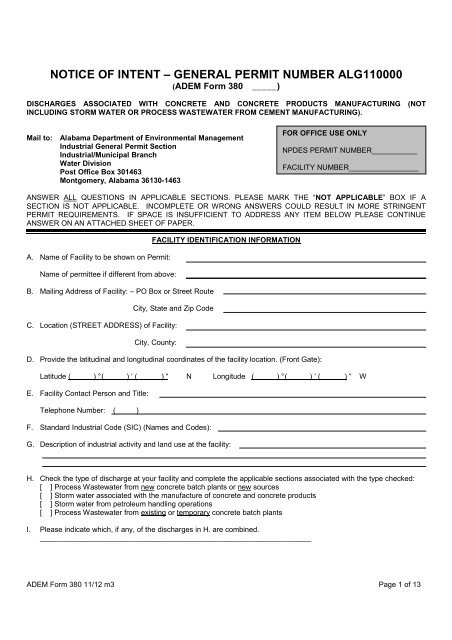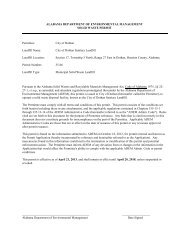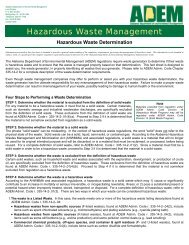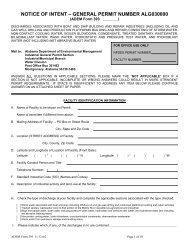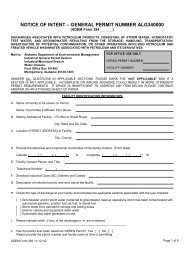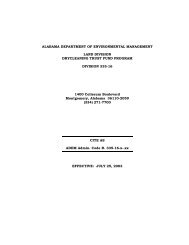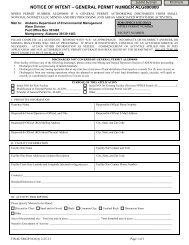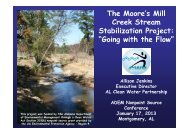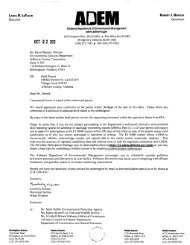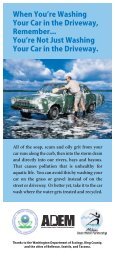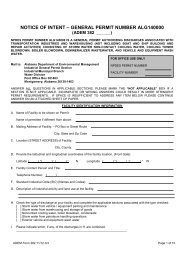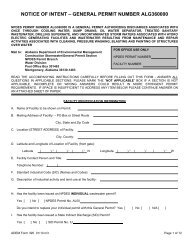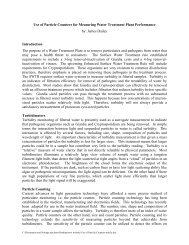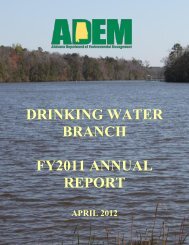General Permit Application Package - NOI-11 - Alabama ...
General Permit Application Package - NOI-11 - Alabama ...
General Permit Application Package - NOI-11 - Alabama ...
You also want an ePaper? Increase the reach of your titles
YUMPU automatically turns print PDFs into web optimized ePapers that Google loves.
NOTICE OF INTENT – GENERAL PERMIT NUMBER ALG<strong>11</strong>0000<br />
(ADEM Form 380 _____)<br />
DISCHARGES ASSOCIATED WITH CONCRETE AND CONCRETE PRODUCTS MANUFACTURING (NOT<br />
INCLUDING STORM WATER OR PROCESS WASTEWATER FROM CEMENT MANUFACTURING).<br />
Mail to: <strong>Alabama</strong> Department of Environmental Management<br />
Industrial <strong>General</strong> <strong>Permit</strong> Section<br />
Industrial/Municipal Branch<br />
Water Division<br />
Post Office Box 301463<br />
Montgomery, <strong>Alabama</strong> 36130-1463<br />
FOR OFFICE USE ONLY<br />
NPDES PERMIT NUMBER___________<br />
FACILITY NUMBER_________________<br />
ANSWER ALL QUESTIONS IN APPLICABLE SECTIONS. PLEASE MARK THE “NOT APPLICABLE” BOX IF A<br />
SECTION IS NOT APPLICABLE. INCOMPLETE OR WRONG ANSWERS COULD RESULT IN MORE STRINGENT<br />
PERMIT REQUIREMENTS. IF SPACE IS INSUFFICIENT TO ADDRESS ANY ITEM BELOW PLEASE CONTINUE<br />
ANSWER ON AN ATTACHED SHEET OF PAPER.<br />
A. Name of Facility to be shown on <strong>Permit</strong>:<br />
Name of permittee if different from above:<br />
B. Mailing Address of Facility: – PO Box or Street Route<br />
FACILITY IDENTIFICATION INFORMATION<br />
City, State and Zip Code<br />
C. Location (STREET ADDRESS) of Facility:<br />
City, County:<br />
D. Provide the latitudinal and longitudinal coordinates of the facility location. (Front Gate):<br />
Latitude ( ) ° ( ) ‘ ( ) “ N Longitude ( ) ° ( ) ‘ ( ) “ W<br />
E. Facility Contact Person and Title:<br />
Telephone Number: ( )<br />
F. Standard Industrial Code (SIC) (Names and Codes):<br />
G. Description of industrial activity and land use at the facility:<br />
H. Check the type of discharge at your facility and complete the applicable sections associated with the type checked:<br />
[ ] Process Wastewater from new concrete batch plants or new sources<br />
[ ] Storm water associated with the manufacture of concrete and concrete products<br />
[ ] Storm water from petroleum handling operations<br />
[ ] Process Wastewater from existing or temporary concrete batch plants<br />
I. Please indicate which, if any, of the discharges in H. are combined.<br />
__________________________________________________________________<br />
ADEM Form 380 <strong>11</strong>/12 m3 Page 1 of 13
J. Has the facility ever been issued an NPDES <strong>Permit</strong>? Yes [ ] No [ ]<br />
Please provide the permit number and facility name at time of permitting.<br />
<strong>Permit</strong> Number: ________________________<br />
Facility Name:__________________________<br />
K. Has the facility been issued an NPDES INDIVIDUAL wastewater permit?<br />
Yes [ ] No [ ] NPDES <strong>Permit</strong> No. AL00<br />
Do you intend to replace your individual permit with this <strong>General</strong> <strong>Permit</strong>? Yes [ ] No [ ]<br />
L. Has the facility been issued a State Indirect Discharge (SID) <strong>Permit</strong>?<br />
Yes [ ] No [ ] SID <strong>Permit</strong> No. IU<br />
M. Is this Notice of Intent for (circle one):<br />
1. First time issuance of a GENERAL <strong>Permit</strong><br />
2. Renewal of GENERAL <strong>Permit</strong> No. ALG<br />
3. Modification of GENERAL <strong>Permit</strong> No. ALG<br />
N. Are any of the discharges that you intend to be covered by this permit going to municipal storm sewer?<br />
Yes [ ] No [ ]<br />
O. Name of surface water to which the municipal storm sewer discharges:<br />
P. Have you notified the municipality by letter as required by 40 CFR 122.26(a)(4)? Yes [ ] No [ ]<br />
Q. Date facility started or will start operations:<br />
R. What is the size of the site in acres? _______________________<br />
S. Do you discharge to any waters of the State that are impaired (303(d) or TMDL)? Yes [ ] No [ ]<br />
(A list of the impaired waters can be found at http://www.adem.state.al.us/programs/water/303d.cnt<br />
for 303(d)listed waters and http://www.adem.state.al.us/programs/water/wquality/20<strong>11</strong>ApprovedTMDLs.zip for waters<br />
subject to a TMDL.)<br />
If yes, do your discharges contain pollutants of concern listed for the impaired water(s)? Yes [ ] No [ ]<br />
If yes, then enhanced BMPs are required. Also, an Individual NPDES <strong>Permit</strong> may be required, so please contact the<br />
Industrial/Municipal Branch of ADEM before proceeding.<br />
T. Is this a temporary concrete batch plant? Yes [ ] No [ ]<br />
A temporary concrete batch plant means a non-permanent structure operating on an existing plant site for less than<br />
730 days cumulatively during the period of coverage under the <strong>General</strong> <strong>Permit</strong>.<br />
ADEM Form 380 <strong>11</strong>/12 m3 Page 2 of 13
DSN0<strong>11</strong> – PROCESS WASTEWATER FROM NEW CONCRETE BATCH PLANTS OR NEW SOURCES<br />
Process wastewater from new concrete batch plants or new sources may ONLY be discharged during or immediately<br />
after (within 24 hours) a 7.5 inch or greater storm event.<br />
NOT APPLICABLE [ ]<br />
A. List latitude and longitude (to seconds) of the point where each discharge exits your property and name of receiving<br />
stream. Also include the type(s) of discharges exiting at each point: process wastewater and wash down, vehicle and<br />
equipment wash water, noncontact cooling water, cooling tower and boiler blowdown, and/or demineralizer<br />
wastewater<br />
1. Latitude ( ) ° ( ) ‘ ( ) “ N Longitude ( ) ° ( ) ‘ ( ) “ W<br />
Receiving Stream<br />
Type(s) of Discharge<br />
2. Latitude ( ) ° ( ) ‘ ( ) “ N Longitude ( ) ° ( ) ‘ ( ) “ W<br />
Receiving Stream<br />
Type(s) of Discharge<br />
3. Latitude ( ) ° ( ) ‘ ( ) “ N Longitude ( ) ° ( ) ‘ ( ) “ W<br />
Receiving Stream<br />
Type(s) of Discharge<br />
B. Mark the type of process water generated at the facility and complete applicable sections associated with the type<br />
marked:<br />
1. Wash down/process water associated with the manufacture of concrete/concrete products<br />
2. Non-contact cooling water<br />
3. Cooling tower blowdown<br />
4. Boiler Blowdown<br />
5. Demineralizer wastewater<br />
6. Vehicle and equipment wash water<br />
C. This <strong>General</strong> NPDES <strong>Permit</strong> requires the development and implementation of a Best Management Practice (BMP)<br />
Plan and a Storm water Pollution Prevention (SPP) Plan. New sources and new facilities shall have in place an<br />
operational and impermeable containment and reclamation procedure/system for all process wastewater produced.<br />
Does the facility have a BMP Plan, SPP Plan, impermeable containment, and reclamation procedure/system in place?<br />
Yes [ ] No [ ]<br />
D. Were there any past industrial activities on the site that would contribute to storm water contamination?<br />
Yes [ ] No [ ] If yes, please explain:<br />
E. Are vehicles/equipment washed on site? Yes [ ] No [ ]<br />
If yes, please give a detailed description of wash water use, additives, location, ultimate disposal, etc.<br />
F. Are the interiors of tank railcars or tank trailers washed out? Yes [ ] No [ ]<br />
If yes, the facility cannot be covered under this <strong>General</strong> <strong>Permit</strong>. Please contact the Industrial Section of ADEM before<br />
proceeding.<br />
ADEM Form 380 <strong>11</strong>/12 m3 Page 3 of 13
G. How are spent oil, hydraulic fluids and any other potential pollutants that are handled on site disposed?<br />
H. Are organic or petroleum based solvents used in washing operations on site? Yes [ ] No [ ]<br />
If yes, the facility cannot be covered under this general permit. Please contact the Industrial Section of ADEM before<br />
proceeding.<br />
I. If there are more than one of these discharges (in A. above), can they be sampled separately? Yes [ ] No [ ]<br />
J. Is there any process water commingled with the cooling and/or blow down water? Yes [ ] No [ ]<br />
K. If answer to J. is yes, can they all be sampled separately? Yes [ ] No [ ]<br />
L. Is the non-contact cooling water and the cooling tower blowdown discharge less than 100,000 gallons per day (GPD)?<br />
Yes [ ] No [ ]<br />
If no, please include the estimated gallons per day of discharge:<br />
GPD<br />
M. Does surface water intake total 2 million gal/day or more? Yes [ ] No [ ]<br />
N. Is 25% or more of the intake used for cooling purposes? Yes [ ] No [ ]<br />
O. Do you use biocides in your cooling or blowdown water? Yes [ ] No [ ]<br />
If yes, please submit a list of the biocide, corrosion inhibitor or chemical additive with this <strong>NOI</strong>. The applicant must<br />
also provide:<br />
(1) name and general composition of biocide or chemical,<br />
(2) 48-hour median tolerance limit data for organisms representative of the biota of the waterway into<br />
which the discharge will ultimately reach. For freshwaster, the fathead minnow (pimephales promelas)<br />
and cladoceran ( Ceriodaphnia dubia) are the required test organisms. For salt water, the organisms<br />
shall be mysid shrimp; and sheepshead minnow or inland silverside.<br />
(3) quantities to be used,<br />
(4) frequencies of use,<br />
(5) proposed discharge concentrations, and<br />
(6) EPA registration of number, if applicable.<br />
* BIOCIDES THAT CONTAIN TRIBUTYL TIN, TRIBUTYL TIN OXIDE, ZINC AND/OR CHROMIUM ARE<br />
PROHIBITED BY THIS PERMIT<br />
P. Is your discharge located in the Tennessee or Cahaba River Basin or on the Tallapoosa River between Thurlow Dam<br />
at Tallassee and the junction of the Coosa River and Tallapoosa River? Yes [ ] No [ ]<br />
Q. Is the boiler blowdown discharge less than 5,000 gallons per day (GPD)? Yes [ ] No [ ]<br />
If no, please include the estimated gallons per day of discharge<br />
GPD<br />
R. Is shock chlorination used at the facility? Yes [ ] No [ ]<br />
S. Is any source water chlorinated? Yes [ ] No [ ]<br />
If so, explain use and list outfall number(s) from A. in this section.<br />
T. Is demineralizer wastewater discharged? Yes [ ] No [ ]<br />
U. Are there any known impacts on the receiving water as a result of the discharge? Yes [ ] No [ ]<br />
If yes, to what extent? ___________________________________________________________________________<br />
ADEM Form 380 <strong>11</strong>/12 m3 Page 4 of 13
V. Is there a cooling water intake structure (CWIS) associated with this facility? Yes [ ] No [ ]<br />
W. Does the provider of your source water operate a CWIS? Yes [ ] No [ ] If your source water is from a WTP that<br />
also supplies drinking water, then the answer is no.<br />
If the answer to both questions V and W is no, then a Cooling Water Intake Structure Form is not required. If the<br />
answer to either or both questions V and W is yes, then a Cooling Water Intake Structure Form must be<br />
completed and attached.<br />
Complete this section only if applicable<br />
NOT APPLICABLE [ ]<br />
COOLING WATER MONITORING OPTIONS<br />
A. Is cooling/blowdown water chlorine free from the time it enters your facility until it is discharged (city water usually<br />
contains chlorine)? Yes [ ] No [ ]<br />
IF ANSWER IS YES, DO NOT COMPLETE THIS SECTION<br />
B. If answer is no, which outfall(s) listed above under DSN0<strong>11</strong> are chlorinated AND are over 2,500 feet from point of<br />
discharge from the facility to the point of entry into the receiving stream?<br />
If you listed any outfalls in question B. you may avoid monitoring for chlorine at that outfall by:<br />
1. Submitting lab data with the Notice of Intent (<strong>NOI</strong>) that demonstrates that the chlorine concentration at the point<br />
the discharge enters the impacted stream is 0.0<strong>11</strong> mg/l or less, AND<br />
2. Submitting a site drawing showing the distance from the discharge point to the point the effluent enters the<br />
impacted stream.<br />
C. For outfalls listed in B. do you intend to exercise the no monitoring chlorine option? Yes [ ] No [ ]<br />
For which outfall(s)?<br />
If your answer is yes to question C. you are certifying by signing this form that the conditions are as stated above in<br />
this Section (Cooling Water Monitoring Options) and you are certifying that you understand that you are required to<br />
notify ADEM if these conditions change during the term of the permit.<br />
ADEM Form 380 <strong>11</strong>/12 m3 Page 5 of 13
DSN002– STORM WATER DISCHARGE INFORMATION ASSOCIATED WITH THE MANUFACTURE OF CONCRETE<br />
AND CONCRETE PRODUCTS FROM CONCRETE BATCH PLANTS<br />
NOT APPLICABLE [ ]<br />
A. List latitude and longitude (to seconds) of the point where each discharge exits your property and name of receiving<br />
stream.<br />
1. Latitude ( ) ° ( ) ‘ ( ) “ N Longitude ( ) ° ( ) ‘ ( ) “ W<br />
Receiving Stream<br />
2. Latitude ( ) ° ( ) ‘ ( ) “ N Longitude ( ) ° ( ) ‘ ( ) “ W<br />
Receiving Stream<br />
3. Latitude ( ) ° ( ) ‘ ( ) “ N Longitude ( ) ° ( ) ‘ ( ) “ W<br />
Receiving Stream<br />
B. Has storm water runoff from the facility been analyzed for presence of any known pollutants? Yes [ ] No [ ]<br />
If yes, attach a copy of analysis.<br />
C. Storm water runoff discharges to:<br />
1. Surface water<br />
2. Seeps into the ground<br />
3. Municipal storm sewer<br />
D. The <strong>General</strong> NPDES Concrete <strong>Permit</strong> requires the development and implementation of a Best Management Practice<br />
(BMP) Plan and Stormwater Pollution Prevention (SPP) Plan. Does the facility have a BMP Plan and SPP Plan in<br />
place? Yes [ ] No [ ]<br />
E. Are there any known impacts on receiving water? Yes [ ] No [ ]<br />
If yes, to what extent?<br />
F. Are any raw materials, finished products, waste products or chemicals exposed to storm water currently or in the last<br />
three years? Yes [ ] No [ ]<br />
If yes, please list:<br />
G. Were there any past industrial activities on the site that would contribute to storm water contamination?<br />
Yes [ ] No [ ] If yes, please explain:<br />
H. Do you manufacture cement from raw materials? Yes [ ] No [ ] If yes, the facility cannot be covered under this<br />
general permit. Please contact the Industrial Section of ADEM before proceeding.<br />
ADEM Form 380 <strong>11</strong>/12 m3 Page 6 of 13
NOT APPLICABLE [ ]<br />
DSN008 – STORM WATER FROM PETROLEUM BULK STORAGE AND FUELING AREAS<br />
A. List latitude and longitude (to seconds) of the point where each discharge exits your property and name of receiving<br />
stream:<br />
1. Latitude ( ) ° ( ) ‘ ( ) “ N Longitude ( ) ° ( ) ‘ ( ) “ W<br />
Receiving Stream<br />
2. Latitude ( ) ° ( ) ‘ ( ) “ N Longitude ( ) ° ( ) ‘ ( ) “ W<br />
Receiving Stream<br />
3. Latitude ( ) ° ( ) ‘ ( ) “ N Longitude ( ) ° ( ) ‘ ( ) “ W<br />
Receiving Stream<br />
4. Latitude ( ) ° ( ) ‘ ( ) “ N Longitude ( ) ° ( ) ‘ ( ) “ W<br />
Receiving Stream<br />
B. List number and size of above ground storage tanks.<br />
List number and size of underground storage tanks.<br />
Number<br />
Size<br />
C. Has storm water runoff from the facility been analyzed for presence of any known pollutants? Yes [ ] No [ ]<br />
If yes, attach a copy of analysis.<br />
D. Storm water runoff discharges to (mark one):<br />
1. Surface water<br />
2. Seeps into ground<br />
3. Municipal storm sewer<br />
E. This permit requires the development and implementation of a Best Management Practice (BMP) Plan. Does the<br />
facility have any of the following other control measures to prevent pollution? Yes [ ] No [ ]<br />
F. Does the facility have any of the following other control measures to prevent pollution?<br />
1. Structural control measures (basins, etc.) Yes [ ] No [ ]<br />
2. Treatment of groundwater (retention, aeration) Yes [ ] No [ ]<br />
3. Other. If so, please describe.<br />
G. Known impact on receiving water? Yes [ ] No [ ] If yes, to what extent?<br />
H. Have any leaks, spills or other instances of storm water contamination occurred within the last 3 years?<br />
Yes [ ] No [ ] If yes, what occurred and how did it happen?<br />
I. Are any above ground tanks that contain a possible pollutant double-walled? Yes [ ] No [ ]<br />
J. Are all above ground tanks that contain a possible pollutant double-walled? Yes [ ] No [ ]<br />
K. Are any above ground tanks that contain a possible pollutant diked? Yes [ ] No [ ]<br />
ADEM Form 380 <strong>11</strong>/12 m3 Page 7 of 13
L. Are all tanks that contain a possible pollutant diked? Yes [ ] No [ ]<br />
M. Can dikes contain <strong>11</strong>0% of the contents of the largest tank in the dike? Yes [ ] No [ ]<br />
N. Are the walls and floors of the dikes relatively impermeable to the stored substance? Yes [ ] No [ ]<br />
O. From which outfalls in A. (this section) is uncontaminated storm water from secondary containment (for above ground<br />
storage tanks only) areas discharged?<br />
P. Is treated or untreated water from tank bottoms or water draws discharged on site? Yes [ ] No [ ] If yes, this<br />
particular discharge cannot be covered under this permit. Please contact the Industrial Section of ADEM before<br />
proceeding.<br />
Q. Were there any past industrial activities on the site that would contribute to the present storm water pollution?<br />
Yes [ ] No [ ] If yes, please explain:<br />
R. Does the facility handle leaded fuels? Yes [ ] No [ ]<br />
S. Does the facility handle aviation fuel, jet fuel, or diesel fuel? Yes [ ] No [ ]<br />
T. Is hydrostatic testing of petroleum handling equipment done on site? Yes [ ] No [ ] If yes, this particular<br />
discharge cannot be covered under this permit. Please contact the Industrial Section of ADEM before proceeding.<br />
U. Are any trucks or equipment fueled at this facility? Yes [ ] No [ ] Is your fueling area protected from storm water<br />
including flowing water? Yes [ ] No [ ] If yes, please explain.<br />
V. Is storm water/wash down water from the fueling/loading area treated (oil/water separator, etc.) prior to discharge?<br />
Yes [ ] No [ ]<br />
W. Does the facility comply with 40 CFR Part <strong>11</strong>2? Yes [ ] No [ ]<br />
Last update of SPCC Plan, if applicable _____________________<br />
In accordance with 40 CFR Section <strong>11</strong>2.5 (b), applicable facilities must complete a review and evaluation of the SPCC<br />
Plan at least once every five years. If the provided date indicates the SPCC Plan is not valid, is the SPCC Plan<br />
currently being reviewed by a Professional Registered Engineer. Yes [ ] No [ ]<br />
If an SPCC Plan date was not entered, is it because the facility’s petroleum storage capacity is below the volume<br />
that would require an SPCC Plan? Yes [ ] No [ ]<br />
X. Is storm water from fueling areas allowed to mix with storm water from other industrial activities? Yes [ ] No [ ]<br />
Y. Does the facility discharge to a public water supply stream segment as defined by ADEM Administrative Code R.<br />
335-6-<strong>11</strong>-.02? Yes [ ] No [ ]<br />
Note: DSN008 requires that the permittee submit an annual petroleum certification by January 28 th that all<br />
discharges during the preceding year were in accordance with the conditions of the permit. If the Department deems<br />
it necessary to require monitoring, then the facility may have additional testing under DSN002.<br />
ADEM Form 380 <strong>11</strong>/12 m3 Page 8 of 13
DSN012 – PROCESS WASTEWATER FROM EXISTING OR TEMPORARY CONCRETE BATCH PLANTS<br />
An existing facility is a facility that was constructed and began operation prior to September 1, 2007. A temporary<br />
concrete batch plant means a non-permanent structure operating on an existing plant site for less than 730 days<br />
cumulatively during the period of coverage under the <strong>General</strong> <strong>Permit</strong>.<br />
NOT APPLICABLE [ ]<br />
A. List latitude and longitude (to seconds) of the point where each discharge exits your property and name of<br />
receiving stream. Also include the type(s) of discharges exiting at each point: process wastewater and<br />
washdown, vehicle and equipment washwater, noncontact cooling water, cooling tower and boiler blowdown,<br />
and/or demineralizer wastewater<br />
1. Latitude ( ) ° ( ) ‘ ( ) “ N Longitude ( ) ° ( ) ‘ ( ) “ W<br />
Receiving Stream<br />
Type(s) of Discharge<br />
2. Latitude ( ) ° ( ) ‘ ( ) “ N Longitude ( ) ° ( ) ‘ ( ) “ W<br />
Receiving Stream<br />
Type(s) of Discharge<br />
3. Latitude ( ) ° ( ) ‘ ( ) “ N Longitude ( ) ° ( ) ‘ ( ) “ W<br />
Receiving Stream<br />
Type(s) of Discharge<br />
B. Circle the type of process water generated at the facility and complete applicable sections associated with the type<br />
checked:<br />
1. Washdown/process water associated with the manufacture of concrete/concrete products<br />
2. Non-contact cooling water<br />
3. Cooling tower blowdown<br />
4. Boiler Blowdown<br />
5. Demineralizer wastewater<br />
6. Vehicle and equipment wash water<br />
C. Has process water discharged from the facility? Yes [ ] No [ ]<br />
If yes, has it been analyzed for presence of any known pollutants? Yes [ ] No [ ]<br />
If yes, please attach a copy of the analysis.<br />
D. The <strong>General</strong> NPDES Concrete <strong>Permit</strong> requires the development and implementation of a Best Management Practice<br />
(BMP) Plan and a Stormwater Pollution Prevention (SPP) Plan. Does the facility have a BMP Plan and SPP Plan in<br />
place? Yes [ ] No [ ]<br />
E. Were there any past industrial activities on the site that would contribute to storm water contamination?<br />
Yes [ ] No [ ] If yes, please explain:<br />
F. Are vehicles/equipment washed on site? Yes [ ] No [ ]<br />
If yes, please give detailed description of wash water use, additives, location, ultimate disposal, etc.<br />
ADEM Form 380 <strong>11</strong>/12 m3 Page 9 of 13
G. Are the interiors of tank railcars or tank trailers washed out? Yes [ ] No [ ]<br />
If yes, the facility cannot be covered under this <strong>General</strong> <strong>Permit</strong>. Please contact the Industrial Section of ADEM before<br />
proceeding.<br />
H. How are spent oil, hydraulic fluids and any other potential pollutants that are handled on site disposed?<br />
I. Are organic or petroleum based solvents used in washing operations on site? Yes [ ] No [ ] N/A [ ]<br />
If yes, the facility cannot be covered under this general permit. Please contact the Industrial Section of ADEM before<br />
proceeding.<br />
J. If there are more than one of these discharges (in A. above), can they be sampled separately? Yes [ ] No [ ]<br />
K. Is there any process water commingled with the cooling and/or blowdown water? Yes [ ] No [ ]<br />
L. If answer to K. is yes, can they all be sampled separately? Yes [ ] No [ ]<br />
M. Is the non-contact cooling water and the cooling tower blowdown discharge less than 100,000 gallons per day (GPD)?<br />
Yes [ ] No [ ]<br />
If no, please include the estimated gallons per day of discharge:<br />
GPD<br />
N. Does surface water intake total 2 million gal/day or more? Yes [ ] No [ ]<br />
O. Is 25% or more of the intake used for cooling purposes? Yes [ ] No [ ]<br />
P. Do you use biocides in your cooling or blowdown water? Yes [ ] No [ ]<br />
If yes, please submit a list of the biocide, corrosion inhibitor or chemical additive with this <strong>NOI</strong>. The applicant must<br />
also provide:<br />
(1) name and general composition of biocide or chemical,<br />
(2) 48-hour median tolerance limit data for organisms representative of the biota of the waterway into<br />
which the discharge will ultimately reach. For freshwaster, the fathead minnow (pimephales promelas)<br />
and cladoceran (Ceriodaphnia dubia) are the required test organisms. For salt water, the organisms<br />
shall be mysid shrimp; and sheepshead minnow or inland silverside.<br />
(3) quantities to be used,<br />
(4) frequencies of use,<br />
W<br />
(5) proposed discharge concentrations, and<br />
(6) EPA registration of number, if applicable.<br />
* BIOCIDES THAT CONTAIN TRIBUTYL TIN, TRIBUTYL TIN OXIDE, ZINC AND/OR CHROMIUM ARE<br />
PROHIBITED BY THIS PERMIT<br />
Q. Is your discharge located in the Tennessee or Cahaba River Basin or on the Tallapoosa River between Thurlow Dam<br />
at Tallassee and the junction of the Coosa River and Tallapoosa River? Yes [ ] No [ ]<br />
R. Is the boiler blowdown discharge less than 5,000 gallons per day (GPD)? Yes [ ] No [ ]<br />
If no, please include the estimated gallons per day of discharge<br />
GPD<br />
S. Is shock chlorination used at the facility? Yes [ ] No [ ]<br />
T. Is any source water chlorinated? Yes [ ] No [ ]<br />
If so, explain use and list outfall number(s) from A. in this section.<br />
U. Is demineralizer wastewater discharged? Yes [ ] No [ ]<br />
ADEM Form 380 <strong>11</strong>/12 m3 Page 10 of 13
V. Are there any known impacts on the receiving water as a result of the discharge? Yes [ ] No [ ]<br />
If yes, to what extent? ___________________________________________________________________________<br />
W. Is there a cooling water intake structure (CWIS) associated with this facility? Yes [ ] No [ ]<br />
X. Does the provider of your source water operate a CWIS? Yes [ ] No [ ] If your source water is from a WTP that<br />
also supplies drinking water, then the answer is no.<br />
If the answer to both questions W and X is no, then a Cooling Water Intake Structure Form is not required. If the<br />
answer to either or both questions W and X is yes, then a Cooling Water Intake Structure Form must be<br />
completed and attached.<br />
Complete this section only if applicable<br />
NOT APPLICABLE [ ]<br />
COOLING WATER MONITORING OPTIONS<br />
A. Is cooling/blowdown water chlorine free from the time it enters your facility until it is discharged (city water usually<br />
contains chlorine)? Yes [ ] No [ ]<br />
IF ANSWER IS YES, DO NOT COMPLETE THIS SECTION<br />
B. If answer is no, which outfall(s) listed above under DSN012 are chlorinated AND are over 2,500 feet from point of<br />
discharge from the facility to the point of entry into the receiving stream?<br />
If you listed any outfalls in question B. you may avoid monitoring for chlorine at that outfall by:<br />
1. Submitting lab data with the Notice of Intent (<strong>NOI</strong>) that demonstrates that the chlorine concentration at the point<br />
the discharge enters the impacted stream is 0.0<strong>11</strong> mg/l or less, AND<br />
2. Submitting a site drawing showing the distance from the discharge point to the point the effluent enters the<br />
impacted stream.<br />
C. For outfalls listed in B. do you intend to exercise the no monitoring chlorine option? Yes [ ] No [ ]<br />
For which outfall(s)?<br />
If your answer is yes to question C. you are certifying by signing this form that the conditions are as stated above in<br />
this Section (Cooling Water Monitoring Options) and you are certifying that you understand that you are required to<br />
notify ADEM if these conditions change during the term of the permit.<br />
ADEM Form 380 <strong>11</strong>/12 m3 Page <strong>11</strong> of 13
GENERAL INFORMATION<br />
Have you included a check for the application fee? Yes [ ] No [ ]<br />
DO NOT SUBMIT APPLICATION AND PERMIT FEE SEPARATELY<br />
CERTIFICATION: I certify under penalty of law that this document and all attachments were prepared under my direction<br />
or supervision in accordance with a system designed to assure that qualified personnel properly gather and evaluate the<br />
information submitted. Based on my inquiry of the person or persons who manage the system or those persons directly<br />
responsible for gathering the information, the information submitted is, to the best of my knowledge and belief, true,<br />
accurate, and complete. I am aware that there are significant penalties for submitting false information including the<br />
possibility of fine or imprisonment for knowing violations.<br />
SIGNATURES<br />
Responsible Official Signature:<br />
Date Signed:<br />
Name and Official title (type or print):<br />
NOTE: This Notice of Intent must be signed by the official representative of the facility who is: the owner, the sole<br />
proprietor of a sole proprietorship, a general partner for a partnership, or by a ranking elected official or other duly<br />
authorized representative for a unit of government or principal executive officer of at least the level of vice president, or a<br />
manager assigned or delegated in accordance with corporate procedures, with such delegation submitted in writing if<br />
required by the Department, who is responsible for manufacturing, production, or operating facilities and is authorized to<br />
make management decisions which govern the operation of the regulated. If the Notice of Intent is not signed, or is found<br />
to be incomplete, it will be returned.<br />
Address:<br />
Phone Number: ( )<br />
DISCHARGE MONITORING REPORTS (DMR) CONTACT – PLEASE COMPLETE<br />
DMR Contact Name and Official title (type or print):________________________________________________________<br />
DMR Contact Address:__________________________________________________<br />
DMR Contact Phone Number: ( )<br />
Name of Individual (type or print):<br />
Name of Firm:<br />
Address:<br />
Phone Number: ( )<br />
PLEASE COMPLETE IF <strong>NOI</strong> IS PREPARED BY A CONSULTANT OR SOMEONE<br />
OTHER THAN AN EMPLOYEE OF THE FACILITY<br />
ADEM Form 380 <strong>11</strong>/12 m3 Page 12 of 13
Please attach a map showing the location of the facility including major highways and/or<br />
landmarks. The map should include the location of the discharge points.<br />
ADEM Form 380 <strong>11</strong>/12 m3 Page 13 of 13


